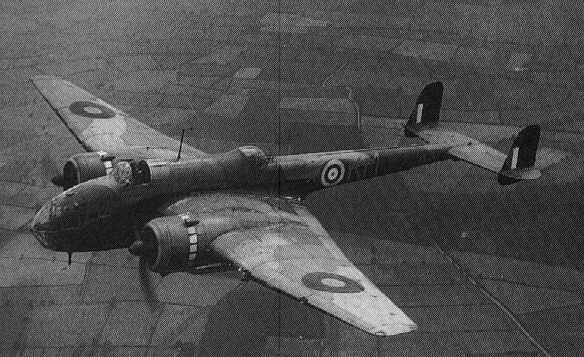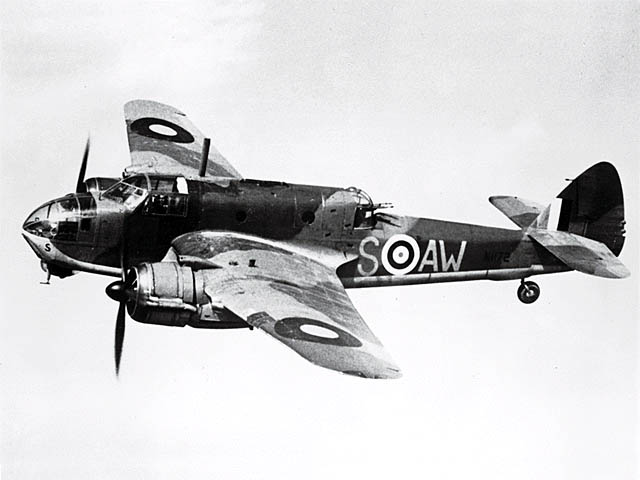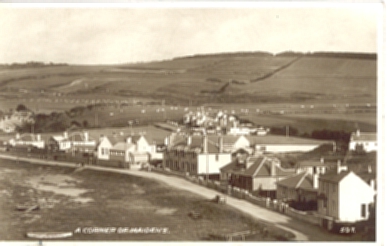Sgt. Leslie Scott (RCAF attached to the RAF) was posted to Turnberry Air Base (an airbase that was created on what was previously, and is now, a famous golf course) for a Hampden long range navigation course in the fall of 1942. Travelling with Phyllis, they made their way by train through London and north to Ayr on the west coast of Scotland about 20 miles south of Glasgow. They arrived late in the day and stopped at a teashop for a bite to eat. They inquired of the owner where they could get a place to sleep for the night and were told they would not be able to find anything at that time of night. The owner of the teashop kindly offered to let them sleep on the floor of the teashop -- and that is what they did. This was in September of 1942 by which time Phyllis was about 6 months pregnant!
| The next morning they took a bus to Girvan, the town just south of Turnberry and Les, in his inimitable way, started walking down the street and knocking on doors to inquire if anyone could accommodate them. Les, being military and on course, would have been provided with accommodation on the base. However, no provisions or allowances were provided for wives travelling with their servicemen husbands during wartime; indeed, it was not supposed to happen! He was eventually able to find a person who would let them have and upstairs room. on Station Road, the main road leading north from Girvan along the coast towards Turnberry. The photo at left shows Leslie in front of this house in 1996 |
With accommodation secured, the next important item was pay. Fortunately, shortly after arriving, a pay parade was held. In those days personnel received their pay in cash from a pay officer. Those to be paid were assembled on a parade square, perhaps organized by course or in some other way. As each person's name was called out he would march up to the paymaster, salute and then his pay would be counted out to him. He would count the money (I never saw anyone with the nerve to do that!) and sign in receipt of it. Then, one step back, salute again, right about face and march back to position. At this particular pay parade, Leslie waited for his name, 'Sgt. Scott', to be called. It wasn't. This could be, and would have been a major problem. Living from pay to pay was the way they lived at that time. To not be paid would be a serious difficulty, particularly since, although he could eat on the base, how would Phyllis eat and how would the rent be paid (it was probably overdue, as it was!). So at the end of the pay parade Leslie marched up to the Flight Sergeant in charge of the parade, a crusty older, regular RAF Flight Sergeant and enquired as to where his pay was, stating that his name had not been called. The Flight Sergeant looked down at his list, and informed him that it had been called -- 'Flight Sergeant Scott' -- and why was he out of uniform? (Leslie was wearing sergeant's stripes without the flight sergeant's crown) And didn't he read orders? And he had better get down to stores and get his crown on his uniform and he could be paid. And in this manner Les learned that he was now a Flight Sergeant. He did get his pay and the Flight Sergeant was much more civil to him, now that he was properly of equal rank.
The First Course
With accommodation and pay sorted out attention could be turned to the course. A course consisted of a number of pilots, navigators and Wireless/Air Gunners (WAGs). From these people crews were created, each with a pilot, navigator and two WAGs. These crews would train together and then go on to operations together. Les's pilot was Spackman, a Canadian from Lethbridge, but he does not remember the names of the WAGs on this crew. Each course had a course number and a photo was taken of the course. Leslie no longer has these for the course, however there is hope we may yet find copies of them.
The purpose of the course was to train crews operations on the Beaufort and Hampden bombers. On completion of the course the crews would be posted to Coastal Command, which was generally considered to be safer than being transferred to Bomber Command.
 |
Handley Page Hampden Mk. I DataCrew : Four (Pilot, Navigator and 2 WAGs) Engines : Two 1,000 hp Bristol Pegasus XVIII Span : 69'-2" (21.08 m) Length : 53'-7" (16.33 m) Height : 14'-11" (4.55 m) Empty Weight : 11,780 lbs. (5,343 kg) Loaded Weight : 18,756 lbs. (8,508 kg) Ceiling : 19,000 ft. (5,791 m) Range : 1,855 miles (2,985 km) with 2,000 lbs (907 kg) of bombs. Armament: One fixed and one movable 0.303" machine gun forward
facing, upper and ventral gun positions each equipped with two 0.303" machine guns.
Maximum bomb load |
 |
In addition to the other problems, Hampden crews also had to contend with the possibility of their aircraft being be mistaken by RAF fighters as a German Dornier Do.17 bomber. Numerous instances of Hampden's being attacked in error by so called "friendly" aircraft were recorded during its operational life. Sadly some of these combats resulted in the loss of both the Hampden and its crew. |
The Hampden Bomber
 |
|
 |
Beaufort Bomber
The course consisted of classroom work and flying assignments. The flying assignments could be dangerous and it appears that most courses would count at least one aircraft and crew lost during training. There were also instances of aircraft colliding with each other on the ground, with resulting casualties
The above photo shows a wartime Hampden flying over England, with a side view diagram below. The pilot sat in the cockpit, naturally, and it is interesting to note in the photograph that the cockpit cover has been pushed back. The navigator sat in the nose which was accessed by pushing his navigational gear and parachite ahead of him as he proceded through a tunnel below the pilot's seat. The wireless operator sat in the bubble above the aircraft and the gunner sat in the bubble below. In anti-submarine operations the aircraft generally flew at low altitudes making the parachutes rather useless.
Leslie on the runways at Turnberry, 1996
A Visit to the Turnberry Clubhouse
At some point during the training, probably in early November, Leslie did not return to Girvan after work. He returned from a training mission and complained of a pain in his abdomen. He ws sent to the base hosptial which admitted him. Phyllis became anxious and was eventually able to determine that Leslie was in the hospital, but could get no other details. This was, in fact, the Turnberry golf course club house which had been converted into a hospital for the duration. Obviously worried, because she new he had been flying and feared there had been an accident, Phyllis decided to make her way to the hospital to see what was wrong. By now it was late in the day and dark (Turnberry is about 55 degrees north, so gets dark early in the day during November). It was overcast or at least moonless when Phyllis, now 7 1/2 months or more pregnant, took the bus up the road towards Maidens and was let off opposite the clubhouse/hospital. In the pitch dark (because of wartime blackout restrictions) she had to make her way up a long staircase to get up to the hospital building on the bluff overlooking the airport. With relief, some level of exhaustion and skinned shins she learned that Leslie had been diagnosed with appendicitis, had been operated on and was fine.
However, the operation meant that Leslie could not complete the course. After recovering from the operation, he was assigned as a supernumerary to base operations to await the next course, thus being separated from Spackmand and the rest of the crew. This course had a tragic future. The course was sent to Malta with Beauforts to strengthen the air defences during what proved to be the last days of the German occupation of North Africa (Operation Torch, the landing of American troops in North Africa, occurred in November of 1942 and the Germans capitulated there in May of 1943). When the course arrived in Malta the WAGs were declared surplus and were ordered back to Britain. They were sent back by air transport and the aircraft involved were shot down over France with the loss of all crews and passengers, thereby killing all of the WAGs who had been on that course. The pilots and navigators stayed at Malta for their tour. Les ran into Spackman in 1945 when they were both on the same ship back to Canada.
The Home in Maidens
During this period, probably about the beginning of December, Les and Phyllis moved to Maidens, the small fishing village just north Girvan and on the edge of the airport. Les had managed to find a family who would rent him their front room, which was on the main floor and only three steps up, as a new home for his soon to be expanded family. The view from the room looked out to the harbour at Maidens on the southern edge of the bay, near the jetty. (This area is known for the cave in which Robert the Bruce contemplated the spider).
The month passed and it became evident that the birth was near. It was decided that Phyllis should go to the Seaforth hospital in Ayr for the delivery. Phyllis entered Seaforth about 26 December. Now Ayr was some distance from Maidens (about 12 miles). In those days what little telephone service was available was mostly tied up by the war effort. In any case, airmen were not supposed to have their wives with them. As a result of this, it was only a day or two after Phyllis delivered Les' first son, to be named Kenneth, that he found out about it. He then made arrangements to go to the hospital and pick Phyllis up and return her to Maidens. Now he did not have a car and could not afford a taxi so he took a bus up to the hospital and brought them back by bus -- but only to Kirkoswald the next village about 2 miles away. From there they took a taxi so as to create the right image in the town! It was only in later years that Les realized that everyone in Maidens would have recognized the taxi as being from Kirkoswald.
 |
|
| Maidens in the 1940's, from a postcard (courtesy Margaret Morrell). The white house in the lower right corner, known as 'Gateside' is the one that we lived in. | The house we lived in, shown in 1996; Kenneth standing on the left in front of the bay window of the room we shared |
A walk on the beach
Sometime about mid-January, Les and Phil went for a walk along the beach at Maidens. They probably often did this, but this walk was different because some scenes from the walk were recorded as photographs. Of course, this being wartime, photographs could not include military facilities and even photographic materials were rationed, so the photos stand out for that reason. The walk was made with a Sergeant who was an American serving with the RCAF (his shoulder flash says 'CANADA' and below the propeller is 'USA', which was worn by Americans who had joined the RCAF). His first name was Johnny but his surname is forgotten. Les remembers trying to locate him a year later and learning that he had been killed on operations. We have the following photographs from this walk
Johnny holding Kenneth Scott, at the age of about two weeks (a copy of this photo was sent to Les'sAunt Lillian with the inscription on the back written by Phyllis "Kenny with a friend of Les's. Taken at a fortnight old") |
Phyllis, Johnny and Agnes McCrindle. Phyllis wrote on the back of this "Me taken with Johnny & his young lady. Can't take a good photo. Les was making some sort of remark wihch made us smile". She marked an 'x' so as to identify herself to Aunt Lillian |
F/S Leslie Scott and his wife Phyllis with Maidens harbour in the background |
Course 23
Sometime after New Years another course assembled at Turnberry. This was course 23 Beaufort and Hampden course. In these courses the crews were assembled from those assigned, after the group had been together for a while. This allowed some opportunity for the course members to create their own crews. One of the course members, Sgt. 'Bim' Verrell RAF, was a bit older than the others and was thinking forward to the extent that he wanted to survive his operational posting and the war. He apparently checked out the pilots and decided that Sgt. Frank Molloy, a New Zealander who had been in a flying club before the war, was the best pilot on the course and he convinced Molloy to have him as a WAG. (Malloy refused his commission later in the war and left the forces as a WO1. He is deceased and never married). Bim then decided that Les was the best navigator and approached him with the proposition that he should join Molloy's crew. In this manner the crew was put together, the fourth person being Sgt. Ben Lyons, RAF. We have a copy of this course photo as well as a blowup of the Molloy crew.
 |
|
Course 23 Beauforts and Hampdens, Flight B |
The Molloy crew: |
Shortly after the course photo was taken the whole course was relocated to Northern Ireland for training, thus bringing an end to Les's first tour at Turnberry. He would return to Turnberry for another posting, but that story will follow later.
© Kenneth Scott and others, 2001